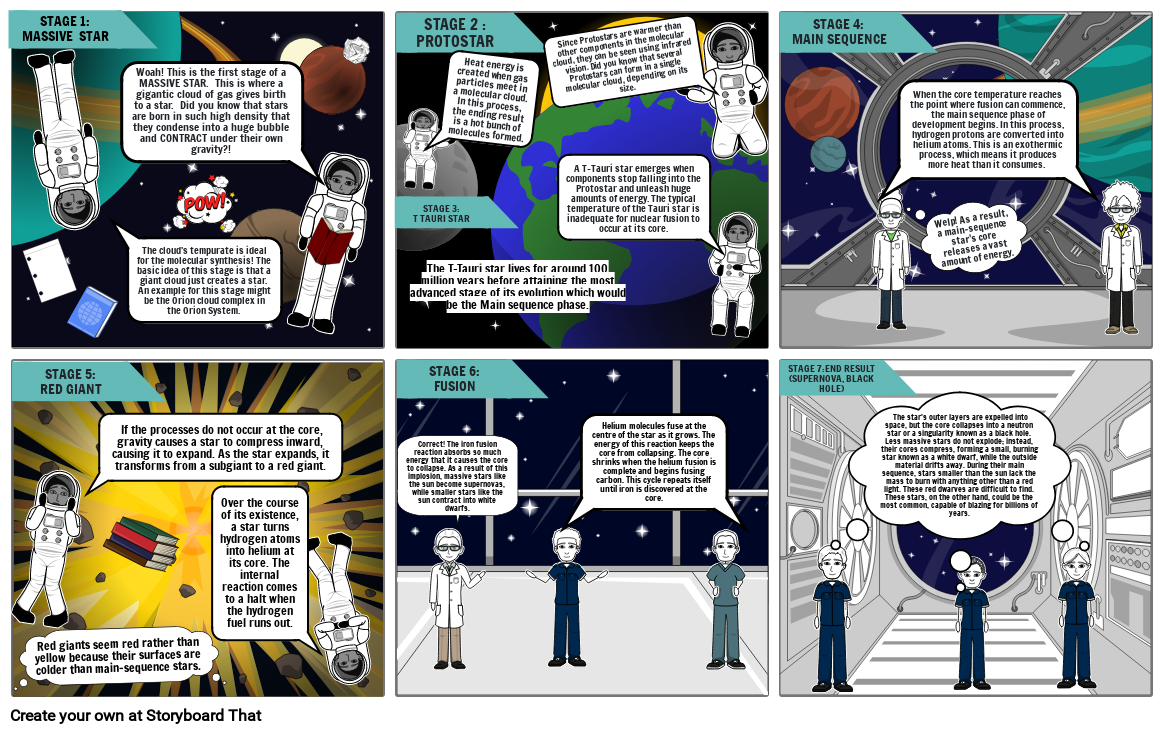star cycle

Texto del Guión Gráfico
- STAGE 1:MASSIVE#160; STAR
- The cloud's tempurate is ideal for the molecular synthesis! The basic idea of this stage is that a giant cloud just creates a star.#160; An example for this stage might be the Orion cloud complex in the Orion System.#160;
- Woah! This is the first stage of a MASSIVE STAR.#160; This is where a gigantic cloud of gas gives birth to a star.#160;#160;Did you know that stars are born in such high density that they condense into a huge bubble and CONTRACT under their own gravity?!
- STAGE 3:T TAURI STAR
- STAGE 2 :PROTOSTAR
- The T-Tauri star lives for around 100 million years before attaining the most advanced stage of its evolution which would be the Main sequence phase.
- Heat energy is created when gas particles meet in a molecular cloud. In this process, the ending result is a hot bunch of molecules formed.
- Since Protostars are warmer than other components in the molecular cloud, they can be seen using infrared vision.#160;Did you know that several Protostars can form in a single molecular cloud, depending on its size.
- A T-Tauri star emerges when components stop falling into the Protostar and unleash huge amounts of energy. The typical temperature of the Tauri star is inadequate for nuclear fusion to occur at its core.
- STAGE 4:#160;MAIN SEQUENCE
- When the core temperature reaches the point where fusion can commence, the main sequence phase of development begins. In this process, hydrogen protons are converted into helium atoms. This is an exothermic process, which means it produces more heat than it consumes.#160;
- Welp!#160;As a result, a main-sequence star's core releases a vast amount of energy.
- STAGE 5:RED GIANT
- Red giants seem red rather than yellow because their surfaces are colder than main-sequence stars.
- #160;If the processes do not occur at the core, gravity causes a star to compress inward, causing it to expand. As the star expands, it transforms from a subgiant to a red giant.
- Over the course of its existence, a star turns hydrogen atoms into helium at its core. The internal reaction comes to a halt when the hydrogen fuel runs out.
- STAGE 6:FUSION
- Correct! The iron fusion reaction absorbs so much energy that it causes the core to collapse. As a result of this implosion, massive stars like the sun become supernovas, while smaller stars like the sun contract into white dwarfs.
- Helium molecules fuse at the centre of the star as it grows. The energy of this reaction keeps the core from collapsing. The core shrinks when the helium fusion is complete and begins fusing carbon. This cycle repeats itself until iron is discovered at the core.
- STAGE 7:END RESULT (SUPERNOVA, BLACK HOLE)
- #160;The star's outer layers are expelled into space, but the core collapses into a neutron star or a singularity known as a black hole. Less massive stars do not explode; instead, their cores compress, forming a small, burning star known as a white dwarf, while the outside material drifts away. During their main sequence, stars smaller than the sun lack the mass to burn with anything other than a red light. These red dwarves are difficult to find. These stars, on the other hand, could be the most common, capable of blazing for billions of years.
Más de 30 millones de guiones gráficos creados

